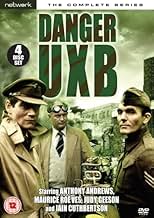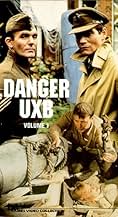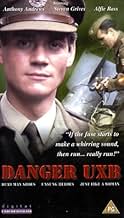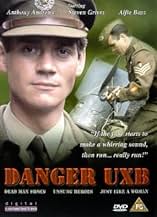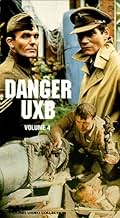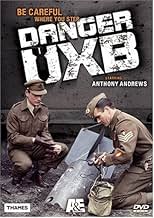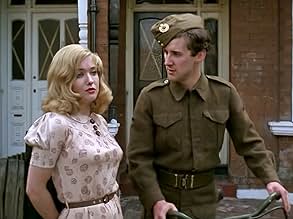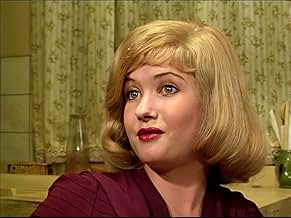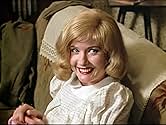Danger UXB
- Serie de TV
- 1979
- 1h
CALIFICACIÓN DE IMDb
8.4/10
1.1 k
TU CALIFICACIÓN
Un drama británico de la Segunda Guerra Mundial sigue la transformación de la Royal Engineer Tunnelling Company 97 en una unidad de desactivación de bombas encargada de desactivar bombas sin... Leer todoUn drama británico de la Segunda Guerra Mundial sigue la transformación de la Royal Engineer Tunnelling Company 97 en una unidad de desactivación de bombas encargada de desactivar bombas sin explotar en Londres durante el Blitz.Un drama británico de la Segunda Guerra Mundial sigue la transformación de la Royal Engineer Tunnelling Company 97 en una unidad de desactivación de bombas encargada de desactivar bombas sin explotar en Londres durante el Blitz.
Explorar episodios
Opiniones destacadas
I just saw it on video 20 years after first watching it on PBS. Great storytelling, great acting, great writing. John Hawkesworth made this well: he neither missed nor flubbed a detail, nor did he insert any improbable or cliched lines or angles. The actual stories themselves are simple enough: a few romances, comradery among the old boys, mateship among the men, a commanding idiot, the proverbial English eccentric ...
But hanging over all their heads - literally - is the Nazi Blitz and its delayed-fuse calling-cards in particular. The fuses kept changing, forcing the engineers to respond to them.
Hawkesworth didn't cop the "budget restraints" plea with "Danger UXB" like so many others would have done; he used what he could get to their fullest. He used the actual techniques used by EOD, RE, in exact detail, using real defused German bombs. I could almost feel the cold mud, a dull counter-part to the sheer terror.
Period pieces are 100% dependent on the details to give their full effect. A wrong uniform, a 50-star flag in the 1940s, an anachronistic hairstyle or remark or attitude gives it all away every time. Hawkesworth gives nothing away in "Danger UXB;" he neither exaggerates nor underplays anything, nor does he throw in a "portent of the future" or "meeting the historical figure."
As for the actors: superlatives won't do them justice. Talent abounds in well-written parts, great and small, with no room for star-tripping anywhere. Every role depends upon with whom they interact. About the only one I thought *may* have been short-shrifted was Maurice Röeves as Sgt. James; he seemed to be chomping on the bit to do more than bark orders, nurse the men or flip a coin through his fingers in a pub. Still, he was thoroughly believable as the backbone of Section 347.
So: I liked it.
But hanging over all their heads - literally - is the Nazi Blitz and its delayed-fuse calling-cards in particular. The fuses kept changing, forcing the engineers to respond to them.
Hawkesworth didn't cop the "budget restraints" plea with "Danger UXB" like so many others would have done; he used what he could get to their fullest. He used the actual techniques used by EOD, RE, in exact detail, using real defused German bombs. I could almost feel the cold mud, a dull counter-part to the sheer terror.
Period pieces are 100% dependent on the details to give their full effect. A wrong uniform, a 50-star flag in the 1940s, an anachronistic hairstyle or remark or attitude gives it all away every time. Hawkesworth gives nothing away in "Danger UXB;" he neither exaggerates nor underplays anything, nor does he throw in a "portent of the future" or "meeting the historical figure."
As for the actors: superlatives won't do them justice. Talent abounds in well-written parts, great and small, with no room for star-tripping anywhere. Every role depends upon with whom they interact. About the only one I thought *may* have been short-shrifted was Maurice Röeves as Sgt. James; he seemed to be chomping on the bit to do more than bark orders, nurse the men or flip a coin through his fingers in a pub. Still, he was thoroughly believable as the backbone of Section 347.
So: I liked it.
I watched this programme when it was first broadcast. I'd not seen it in 40 years until Talking Pictures started showing it again recently. I wondered how well it would stand up now. I wasn't disappointed, it is exceptional. If you get a chance to watch it from the beginning, don't miss it. Drama at its very best.
This is an outstanding story of a British EOD (Explosive Ordnance Disposal) Detachment during World War II. The ordnance depicted along with the fusing used was actually used by the Germans during WWII. The methods used in the show are the actual (in some cases, trial and error) procedures used to defeat the ordnance during WWII.
The RSP (render safe procedures) used today for foreign ordnance is usually classified. The main reason for this is so the enemy doesn't know that you can defeat his weapons. The British, during WWII, initially published that they defeated certain German ordnance and the RSP used as a morale booster for the citizens. The Germans, reading these accounts, then designed some of the fuses with booby traps specifically designed to kill the British EOD soldiers while they were working on the UXBs if they followed the published procedures.
During WWII, the US Army EOD was modeled after the British detachments. Initially, the US turned to the British for training and help in getting our own EOD units established.
One of my greatest joys from this series was the fact that I had taped it the first time I watched and then got to watch it over again with a close friend. The significance of this was: 1) I was US Army EOD, and 2) the close friend was a British EOD tech who had been awarded the George's Medal for his EOD work in Northern Ireland. To show what a tight knit group EOD personnel are - we still stay in touch with one another via the Internet after 26 years (we watched the show together in 1983).
The RSP (render safe procedures) used today for foreign ordnance is usually classified. The main reason for this is so the enemy doesn't know that you can defeat his weapons. The British, during WWII, initially published that they defeated certain German ordnance and the RSP used as a morale booster for the citizens. The Germans, reading these accounts, then designed some of the fuses with booby traps specifically designed to kill the British EOD soldiers while they were working on the UXBs if they followed the published procedures.
During WWII, the US Army EOD was modeled after the British detachments. Initially, the US turned to the British for training and help in getting our own EOD units established.
One of my greatest joys from this series was the fact that I had taped it the first time I watched and then got to watch it over again with a close friend. The significance of this was: 1) I was US Army EOD, and 2) the close friend was a British EOD tech who had been awarded the George's Medal for his EOD work in Northern Ireland. To show what a tight knit group EOD personnel are - we still stay in touch with one another via the Internet after 26 years (we watched the show together in 1983).
By now, anyone who hasn't seen this incredible series but has drifted across the reviews here with know that this amazing series is about an ordnance unit in Britain during the worst days of World War II as the Germans dreamed up increasingly ingenious bombs for killing British citizenry. As you follow individual members of the unit through the vicious business of trying to outsmart inventors whose main objective in life is killing if not civilians then the bomb-disposal experts, you can't help but cringe every second that one of the UXB heroes is working on a bomb. This is real-life, gut-wrenching drama at its best. Any of those bombs can go up at any second - and some of them do. With well-delineated characters which we can empathize with, this was one series that I went so far as requesting The History Channel to repeat. I thought I'd died and gone upstairs when they actually did. You won't want to miss a single episode, and you'll grip the edge of the chesterfield and clench your teeth as they try to deal with the fascinating array of different bombs. Way to go, Mr. Hawkesworth!!
Just finished viewing the 13 episode, 4 disk DVD set of "Danger UXB". Second time around--I saw the series many years ago on PBS.
All the performances are outstanding but, I would like to single out Maurice Röeves as Sergeant James. Why he did not win a best actor award for 1979 is beyond me. I checked his IMDb biography...no awards. Maurice Röeves uncompromising portrayal ranks, in my opinion, right up with George C. Scott's "Patton" for outstanding screen performances.
Rent (or buy) the 4 disk DVD set--well worth the 13 viewing hours. DVD picture and sound are very good. My only complaint about the DVD production--no closed captioning. The text is useful (to this mid-westerner) for understanding rapidly spoken dialogue.
All the performances are outstanding but, I would like to single out Maurice Röeves as Sergeant James. Why he did not win a best actor award for 1979 is beyond me. I checked his IMDb biography...no awards. Maurice Röeves uncompromising portrayal ranks, in my opinion, right up with George C. Scott's "Patton" for outstanding screen performances.
Rent (or buy) the 4 disk DVD set--well worth the 13 viewing hours. DVD picture and sound are very good. My only complaint about the DVD production--no closed captioning. The text is useful (to this mid-westerner) for understanding rapidly spoken dialogue.
¿Sabías que…?
- TriviaBy a bizarre coincidence, actor Anthony Andrews was jotting down some thoughts for a series about wartime bomb-disposal officers when producer John Hawkesworth telephoned him and, out of the blue, offered him the role of Brian Ash in Danger UXB (1979).
- ConexionesFeatured in Verity Lambert: Drama Queen (2008)
Selecciones populares
Inicia sesión para calificar y agrega a la lista de videos para obtener recomendaciones personalizadas
- How many seasons does Danger UXB have?Con tecnología de Alexa
Detalles
Contribuir a esta página
Sugiere una edición o agrega el contenido que falta

